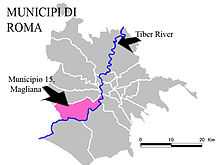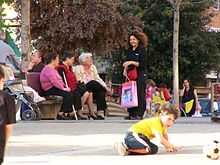Magliana

The Magliana neighborhood or ward is located on the South-West periphery of Rome, Italy along the Tiber River. The neighborhood dates back to the mid-1900s and is home to a diverse group of people of all ages and ethnicities. About 40,000 people reside in Magliana; housing is made up of mostly owner-occupied apartments in 7-8 story apartment buildings.

The space is home to a good deal of economic activity that stretches from the main street, Via Della Magliana in the North-West of the neighborhood, to the South-East towards the Tiber River. However, businesses, activity, and buildings taper off as the neighborhood nears the river bank. Finally, between the built neighborhood and the river is a running trail along an area of farmland.
The neighborhood is confined by the Tiber River on the East and Railroad tracks on the West edge.
In the center of Magliana there are two main areas of congregation: Piazza Fabrizio De Andre and the Mercato Magliana (Magliana Market). The Piazza Fabrizio De Andre is consistently filled with people; in the morning the older generation can be seen sitting on the many benches or strolling through. In the afternoon through early evening it is usually filled with more than 60 children playing on the playground equipment. The Mercato Magliana is open in the morning and early afternoon and offers a wide variety of goods at discount prices.

History
Magliana began as an informal settlement taken over by migrants from other parts of Italy. The engineer Michelangelo Bonelli was the owner during this time period of illegal settlement. As the population began to grow, the lack of basic necessities became more evident. Homes did not contain running water nor sewage systems. In addition, the residents lived in increasingly crowded conditions as the population grew. In 1931, the government drafted and later implemented the Piano de 1931 (Comitato di Quartiere, 1977). Even though Magliana contained a high concentration of people living in poverty, the government chose to develop EUR instead of Magliana.[1] The government ignored the underprivileged and underdeveloped state of Magliana and its residents, which enraged the community. Eventually, speculators gained control of the area. Abusivismo, or speculators constructing buildings without abiding by building regulations, resulted from this, meaning that speculators constructed buildings without abiding by building regulations. This led to the construction of buildings located below river level. These buildings violated construction regulations because due to the threat of possible flooding. Many apartment complexes remain illegal due to their location and lack of modification to accommodate the natural environment.
Community Activism
Magliana was historically an underserviced community that has fought to receive fair treatment from city and municipal authorities. Because Magliana was created by speculators in the 1970s in violation of construction regulations, it was not connected to city water, electricity, and sometimes power lines. Open spaces, sidewalks and roads were poorly maintained as well.

Neighborhood residents organized, lobbied and protested, demanding that their neighborhood be incorporated into greater Rome. The Comitato dei Quartieri della Magliana played a critical role in organizing residents. During the 1970s, they even published a community newsletter.
Another area of activisim in Magliana concerned evictions. Many of Magliana’s residents were unprivileged during the 1970s. Landlords would demand unmanageable rents from residents, even though apartments were sometimes not connected to water and telephone lines. Residents organized to halt evictions by developing strong networks, informing each other of pending evictions, and on the day of the intended evictions, they would telephone each other when the police entered the neighborhoods and residents would gather in the streets and physically prevent police from entering the neighborhood. As a result of this activism, fewer evictions occurred in Magliana over time.
Though the amount of activist activity in Magliana has decreased since the 1970s, there is still a significant amount of community organizing. There are squatter settlements in Magliana which house people who for whatever reason are not able to obtain housing. These are primarily run by communist and socialist organizations.
On the more organized end of the spectrum, the Comitato di quartiere still holds activities. They also teach an Italian language class for immigrants two days a week.
See also
References
- ↑ (Paese Sera, 1979
Coordinates: 41°49′52″N 12°24′06″E / 41.83111°N 12.40167°E